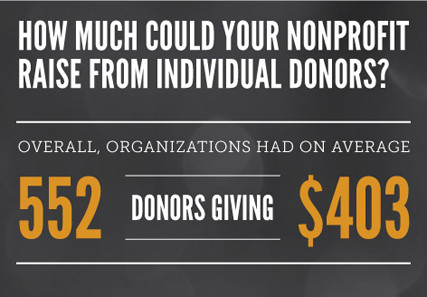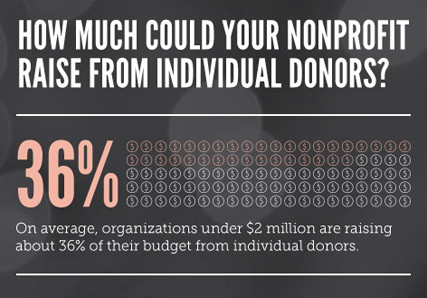A few years ago, I was talking fundraising with a colleague and nonprofit executive director about her fundraising plans for the coming year. A few minutes into the conversation, she asked, “So do you think we can raise $50,000 from individual donors next year?”
I was glad she couldn’t see my face as I responded, “Maybe. How much have you raised in the past?”
As we began to talk about the organization’s fundraising program, it was clear she didn’t have the information needed to answer her question. And unfortunately, I didn’t have any data to help her answer it either.
At that time, there was no accurate, detailed fundraising data available for organizations with budgets less than $2 million. Sure, there were reports that looked at all giving or even zeroed in on online fundraising, but the data was inapplicable for smaller organizations. An organization that raises $30,000 from 100 people cannot accurately compare itself with an organization that raises $3 million from 10,000 people.
Are you enjoying this article? Read more like this, plus SSIR's full archive of content, when you subscribe.
As a math major with a history of fundraising and a love of data, I set out to solve this problem. And in 2012, I conducted the first individual donor benchmark study. This year marks our third year of producing the study and report, citing survey data from 29 US organizations—all with budgets under $2 million and a focus on individual donor fundraising. Although the results are not statistically significant (a feat that is virtually impossible to accomplish), they do provide some useful benchmarks for organizations. We’ve also seen that important results, such as average gift amount, have remained consistent year over year.
 (Image courtesy of Third Space Studio)
(Image courtesy of Third Space Studio)
We found that the average organization with budgets less than $2 million saw significant growth between 2012 and 2013, including a 14 percent jump in overall revenue and an 18 percent increase in individual donor revenue. But even with this growth, we identified some huge opportunities for small organizations to increase individual donor fundraising success. Here’s a look:
Online Giving
Online revenue from individual donors saw the biggest increase: 79 percent between 2012 and 2013. But online donations currently represent only 16 percent of all individual donor revenue—an increase from 13 percent in 2011—but still a small slice of the pie. Online donations also tend to be smaller than offline donations, with an average gift of $94 for online donations, as compared to $403 for all individual donations.
Recurring Donations
Recurring donations—those donors automatically give monthly or at regular intervals—continue to be a source of large gifts for smaller nonprofits. The average gift from these donors is $625, which is 55 percent more than the overall average.
However, only 4 percent of donors are making recurring gifts, so there’s great potential to grow this powerful type of individual giving.
Major Donors
 (Image courtesy of Third Space Studio)
(Image courtesy of Third Space Studio)
Another opportunity for individual donor success is at the upper end of the donor spectrum. Most healthy organizations have a donor base with 60 percent of revenue raised from the top 10 percent of donors.
For the average organization in the survey (with 552 donors giving a total of $168,042), those percentages would translate into 55 donors giving an average of $1,833 each.
We asked organizations how many donors gave more than $1,000 in a year— and the average organization only had 15. That’s about 40 fewer than the archetypal organization of the same size. There’s great potential to find new donors and upgrade existing donors to fill out the top of the spectrum.
It’s my hope that organizations use the data in this study to determine:
- Your fundraising program’s strengths. These are good areas to celebrate with your team and great areas to focus on for growth.
- Your biggest challenges. Find the places where your program doesn’t quite measure up and test out some strategies for improvement.
- Your realistic goals for the future. If you are starting a new program or have little fundraising data, try using the report averages for your size organization to help identify realistic goals.
Support SSIR’s coverage of cross-sector solutions to global challenges.
Help us further the reach of innovative ideas. Donate today.
Read more stories by Heather Yandow.

